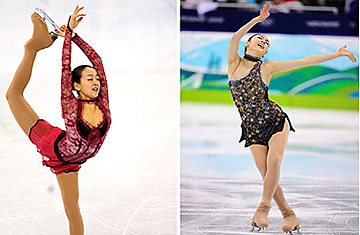
Japanese figure skater Mao Asada, left, and South Korean figure skater Kim Yu-na are competing at the Vancouver Winter Olympics
(2 of 2)
At least for the fans. The photographers from both nations, on the other hand, are just trying to keep up with the insatiable appetite for anything skating back home. Up early like Han to secure their spots, they snooze behind their cameras at their rinkside stations to while away the hours as they await competition, making up for their predawn wake-up calls. During the practice sessions, the fluttering of their rapidly firing shutters almost drowns out the sound of the skaters' music.
And that was just for the short program. The stakes are even higher on Thursday, with a gold medal and the title of new Olympic ice queen on the line. Kim leads Asada by 4.72 points, after both women executed near flawless performances to get the competition started on Tuesday. Asada skated first, landing a strong triple-Axel double-toe jump combination and making history as the first woman to land a triple-Axel combination jump at the Olympics (another Japanese skater, Midori Ito, landed a solo triple-Axel jump at the 1992 Games).
Almost two minutes into Asada's program, Kim, scheduled to skate next, brushed past the curtains and emerged into the arena just as the large flag-waving Japanese contingent roared its appreciation for her rival. "I was trying not to hear, but you can't help but hear the score," Kim said of Asada's season's best of 73.78. But Kim answered back quickly by dispatching a triple-Lutz triple-toe-loop combination that earned her 12 points, to Asada's 10.10 for her history-making triple-Axel double-toe-loop combination. Like the secret agent she was portraying in her program, Kim then masterfully executed element after element, weaving technical precision with artistic expression that earned her own season's best score from the judges. "The short program is so short, and there are so many requirements, but Yu-na is able to make it into something fun and attractive to look at," says Michelle Kwan, the most decorated U.S. skater, who earned a silver medal at the Salt Lake City Games and is in Vancouver as a skating correspondent.
As if the Kim-Asada rivalry isn't dramatic enough, the women's event also features one of the most courageous athletes of the Games: Canadian Joannie Rochette, who competed on Tuesday just two days after learning of her mother's unexpected death from a heart attack. Taking to the ice in front of an appreciative but apprehensive audience that seemed ready to mentally lift her through her program, Rochette put them at ease with a solid program that landed her in third place. It was only after she finished that she allowed herself to acknowledge the affection from the crowd, breaking down in tears as she waited for her scores.
"I experienced a similar trauma two years ago before I was about to compete in Korea, and that is still difficult for me to think about," Kim said of Rochette's skate. "I thought to have it happen at the Olympics would be more of a burden, so I understand what she is feeling." "There were so many heavy hearts in the rink and in the nation," Canada's legendary skater Brian Orser (who is coaching Kim) said the day after Rochette skated. "I was just hoping she would be able to feel the support and love that was there for her, and that that would help carry her through."
On Friday morning in Asia, millions of South Koreans and Japanese will be rooted in front of their screens for the women's final, as Kim and Asada battle for the gold. The entire nation of Canada will be rooting for Rochette as she tries to make it through this difficult week. Under the scoring system, the less than five points that separate Kim and Asada isn't a huge gap. Asada is planning on throwing in two more triple-Axels, an astounding feat if she can land them, but one that she will need in order to beat Kim, whose technical precision on spins and footwork can pile on the points. "She has nothing to lose," says Kwan of Asada's strategy for the free program. "She's got to nail the two triple-Axels thinking that Yu-na will do a clean program. If Yu-na does a clean program, the only way Mao can be competitive with her is to do both triple-Axels and her jump combination."
"It keeps everybody on the edge of their seats, and that's exciting," Orser says of the competition between Kim and Asada. "It's exciting for Yu-na. She's a pretty fierce competitor, and this is no time to hold back."
